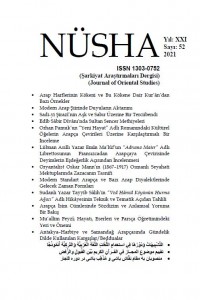ORHAN PAMUK’UN “YENİ HAYAT” ADLI ROMANINDAKİ KÜLTÜREL ÖĞELERİN ARAPÇA ÇEVİRİLERİ ÜZERİNE KARŞILAŞTIRMALI BİR İNCELEME
Abstract
Orhan Pamuk, Türk edebiyatının Nobel Edebiyat Ödülü’nü alan ilk yazarıdır. 1994 yılında kaleme aldığı Yeni Hayat romanı, okuduğu bir kitaptan etkilenen ve kitabın vaat ettiği yeni hayatın peşinden koşan genç bir kahramanın olağanüstü hikâyesini anlatmaktadır. Hayat, melek, aşk ve ölüm gibi birçok kavramı ele alan roman barındırdığı kültürel ögeler açısından oldukça zengin bir yapıya sahiptir. Dil aktarım sanatını kullanarak bu tür ögelerin erek dile aktarımı oldukça önemlidir. Bunun yanı sıra çeviri yapılan dilin anadil veya ara dil olması durumunda kaynak dil kültürünün korunumu ve çevirmenin erek metindeki görünürlük düzeyinin anlaşılması hususları araştırmanın sorularını teşkil etmektedir. Bu çalışmada, Peter Newmark’ın A Textbook of Translation adlı kitabında yer alan sınıflandırma doğrultusunda Orhan Pamuk’un Yeni Hayat romanında geçen kültürel ögeler içerik analizi yöntemi kullanılarak tespit edilmiştir. Bu ögelerin, Abdulkadir Abdelli, Bekr Sıdkî ve Suhâ Sâmih Hasan tarafından Arapçaya yapılan üç çevirisi, önce Aixela’nın belirlediği kültür odaklı çeviri stratejileri bağlamında incelenmiş olup ardından Venuti’nin yerlileştirme ve yabancılaştırma stratejilerine göre çeviri analizleri yapılmıştır. Çalışmanın sonucunda, kültürel ögelerin hangi stratejiler kullanılarak erek dile aktarıldığı, yapılan çevirilerin kaynak dil kültürünü ne derece yansıttığı, ara dilden yapılan çeviride ara dil kültürünün erek metne yansıması ve çevirmen kararları açıklanmıştır.
Keywords
Orhan Pamuk Yeni Hayat Kültürel Ögeler Newmark Aixela Venuti
References
- Aixela J. F. (1996) Culture-specific items in translation. ın Alvarez, R. & Vidal, M. C. (Eds.) Translation, Power, Subversion (pp. 52-79). Clevedon: Multilingual Matters.
- Akalın, Ş. H., Toparlı, R., Argunşah, M., Demir, N., Gözaydın, N., Özyetgin, M., . . . Tekeli, S. (2011). Türkçe Sözlük. Ankara: Türk Dil Kurumu.
- Eagleton, T. (2011). Kültür Yorumları. (Ö. Çelik, Çev.) İstanbul: Ayrıntı Yayınları.
- Köksal, D. (1995). Çeviri kuramları. Ankara: Neyir.
- Newmak, P. (1988). A text book of translation. UK: Prentice Hall.
- Pamuk, O. (2001). el-Hayat el-cedide (A. Abdelli, Çev.). Şam: Ward.
- Pamuk, O. (2001). el-Hayat el-cedide (B. Sıdkî, Çev.). Şam: Ninawa.
- Pamuk, O. (2007). el-Hayat el-cedide (S. S. Hasan, Çev.). Lübnan: El-Hey'etu'l-Mısriyyeti li'l-kitab.
- Pamuk, O. (2017). Yeni hayat. İstanbul: Yapı Kredi.
- Suçin, M. H. (2013). Öteki dilde var olmak Arapça Eşdeğerlik. Ankara: Say.
- Toven, M. B. (1924). Yeni Türkçe Lügat. Türk Dil Kurumu Yayınları: Ankara.
- Türk Dil Kurumu. (2011). Türkçe Sözlük. Ankara: TDK.
- Venuti, L. (1998). Translator’s invisibility: A history of translation. London and New York: Routledge.
- Venuti, L. (ed.) (1992). Rethinking Translation: Discourse, Subjectivity, Ideology. London and New York: Routledge.
A Comparative Analysis on the Arabic Translations of the Cultur-Specific Items in Orhan Pamuk's "New Life"
Abstract
Orhan Pamuk is the only Turkish writer to receive the Nobel Prize for Literature. The novel of Yeni Hayat, written in 1994, tells the extraordinary story of a young man who is influenced by a book he read and pursues the new life the book promises. The novel, which deals with many concepts such as life, angel, love, and death, has a very rich structure in terms of cultural elements. Within the framework of translation studies, the transformation of cultural elements to the target language is an important area of study on which there are many discourses. In addition, if the translated language is the mother tongue or an intermediate language, the issues of preserving the source language culture and understanding the visibility level of the translator in the target text constitute the research questions. In this study, in line with the classification in Peter Newmark's A Textbook of Translation, cultural elements in Orhan Pamuk's novel The New Life were determined using content analysis method. Three translations of these elements into Arabic by Adulkadir Abdelli (2001), Bekr Sıdkî (2001) and Suhâ Sâmih Hasan (2007) were first examined in the context of Aixela's culture-oriented translation strategies, and then translation analysis according to Venuti's Domestication and Foreignization strategies. The result of the study shows the strategies used to convey the cultural elements to the target language, and to what extent the translations reflect the cultural elements that take place in the source language. It also demonstrates the reflection of the relay language culture on the target text. Moreover, the translator's decisions were explained.
Keywords
Translation Studies Translation Strategies The New Life Orhan Pamuk Newmark Aixela Domestication Foreignization.
References
- Aixela J. F. (1996) Culture-specific items in translation. ın Alvarez, R. & Vidal, M. C. (Eds.) Translation, Power, Subversion (pp. 52-79). Clevedon: Multilingual Matters.
- Akalın, Ş. H., Toparlı, R., Argunşah, M., Demir, N., Gözaydın, N., Özyetgin, M., . . . Tekeli, S. (2011). Türkçe Sözlük. Ankara: Türk Dil Kurumu.
- Eagleton, T. (2011). Kültür Yorumları. (Ö. Çelik, Çev.) İstanbul: Ayrıntı Yayınları.
- Köksal, D. (1995). Çeviri kuramları. Ankara: Neyir.
- Newmak, P. (1988). A text book of translation. UK: Prentice Hall.
- Pamuk, O. (2001). el-Hayat el-cedide (A. Abdelli, Çev.). Şam: Ward.
- Pamuk, O. (2001). el-Hayat el-cedide (B. Sıdkî, Çev.). Şam: Ninawa.
- Pamuk, O. (2007). el-Hayat el-cedide (S. S. Hasan, Çev.). Lübnan: El-Hey'etu'l-Mısriyyeti li'l-kitab.
- Pamuk, O. (2017). Yeni hayat. İstanbul: Yapı Kredi.
- Suçin, M. H. (2013). Öteki dilde var olmak Arapça Eşdeğerlik. Ankara: Say.
- Toven, M. B. (1924). Yeni Türkçe Lügat. Türk Dil Kurumu Yayınları: Ankara.
- Türk Dil Kurumu. (2011). Türkçe Sözlük. Ankara: TDK.
- Venuti, L. (1998). Translator’s invisibility: A history of translation. London and New York: Routledge.
- Venuti, L. (ed.) (1992). Rethinking Translation: Discourse, Subjectivity, Ideology. London and New York: Routledge.
Details
| Primary Language | Turkish |
|---|---|
| Subjects | Language Studies |
| Journal Section | Articles |
| Authors | |
| Publication Date | June 24, 2021 |
| Submission Date | December 18, 2020 |
| Acceptance Date | January 28, 2021 |
| Published in Issue | Year 2021 Volume: 21 Issue: 52 |

